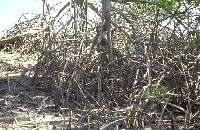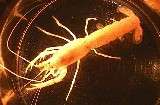Crocodiles live in tidal rivers. Crocodiles are connected to other animals and plants in the river in a web of life.
|
Mangroves provide shade
Mangroves are trees that can survive in saltwater. Mangroves grow on the river bank where the tide rises and falls up to 6m each day. Mangrove roots stick out of the mud to 'breathe' when the tide goes out. Crocs lie in the shade of the mangroves in summer. In winter, they bask on the muddy bank at low tide.
Mangroves shelter fish and crabs
Mangrove roots provide shelter for young fish such as mullet, shrimp and prawns. These animals are food for young crocs. Rotting mangrove leaves provide food for salmon catfish and crabs. These animals are eaten by crocs when they get older. |

Mangrove roots |
| |
|
 |
Small animals live on the river bank
Small lizards, frogs, snakes, rats, bats and birds are food for young crocs. They lie at the river's edge, snapping at movements in the water beside them. |
|
Crocodiles nest on the river bank
Estuarine crocs nest during the wet season (November to April). The nest is a mound of vegetation near the rivers edge. The female lays about 50 eggs and defends her nest.
After about 90 days, the baby crocs chirp inside their eggs. The female digs them out of the nest. From 500 eggs, only about 2 or 3 will become adult crocs. Eggs and baby crocs are eaten by water pythons, long-necked turtles, birds such as jabirus and other crocs
|

Estuarine croc guarding her nest |
| |
|
Big fish live in the river
Fish such as barramundi feed on the marine life amongst the mangroves. Turtles feed on insects and algae. Mudcrabs and catfish scavenge on the river bed. In turn, they become food for the growing crocodile.
Birds feed in the river
Fish, shrimp and crabs are eaten by shorebirds such the jabiru and greater billed heron. Birds are very wary of crocodiles but seem to ignore them. Many of these birds and ducks are eaten by crocodiles. |

Shrimp |
| |

Wild pig |
Land animals drink at the river
Pigs, wallabies, dingoes and horses drink at the river's edge. They are prey for large crocs lying in the river. Only the croc's eyes, nostrils and ears can be seen. The croc swims underwater towards its prey. At the last minute, the croc lunges. The prey is caught by surprise in the croc's powerful jaws. The croc rolls in the water until the prey is dead. Crocs can live for months without eating because they do not use much energy. |
Crocs communicate with each other
Crocs are social animals. They communicate with sounds and body language. To growl, the croc snorts air through the throat or nostrils. The sound is like an idling outboard motor. Baby crocs 'chirp' when they are ready to hatch. Crocs also communicate through their behaviour. Males fight to set up their territories. Snout-lifting means 'you win.' Crocs have a 'pecking order' where the strongest crocs get the best territories.
|